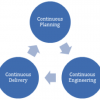 |
What Kind of Agile Coach Should I Hire? Having your organization make the mental shift necessary to adopt agile is the first important step in an agile transformation. But once you decide you want to change, now what? Should you attempt your agile adoption yourselves or hire an expert? Joel Bancroft-Connors details the benefits and downsides of going it alone and of using contract, consultant, and full-time agile coaches so you can decide what's best for you. |
|
 |
The 4 C’s of Managing Distributed Agile Teams Scrum works well for collocated teams, but working with distributed teams brings its own different challenges. There should be some controls in order to prevent instability, ambiguity, and tension from turning into chaos. As the ScrumMaster is the servant leader of the team, here are four important initiatives the ScrumMaster can take to guide their teams—the four C’s of managing distributed agile teams. |
|
 |
Embracing the Learning Curve in Software Development In software development, we're constantly learning new skills because we have to. Technology and its associated best practices are constantly changing, but this is a good thing—it means our industry is evolving quickly. It also means we are constantly on the learning curve. Having a good mindset about continuously learning can help you go far in the software world. |
|
 |
Measuring the Performance of Your Operations Center Many organizations have problems with consistently tracking and measuring system outages. Issues aren't logged, admins make changes to systems without going through change management, and a high number of issues turn out to be recurring problems. Implementing a performance measurement process calculates system reliability and can help you improve consistency. |
|
 |
Agile Is Not a Process, It’s a Mindset Agile transformation requires more than a change in process; it needs a change in mindset. In order to fully embrace agile and create a productive environment, you have to change how you think about priorities and failure. Priorities are decided proactively, not reactively, and failure is not punished, it is celebrated. Once you make this shift in perspective, you can reap the rewards of agile. |
|
 |
Applying Agile to Life: Taking Retrospectives outside the Workplace A lot of what agile teams do can be used effectively outside software development teams, and even outside the typical business organization. For instance, retrospectives and the practice of talking about what went well, what you should keep doing, and what can be improved can be applied anywhere—even to families. Read on to learn how to bring continuous improvement into your daily life. |
|
 |
3 Keys to Mastering Test-Driven Development From his decade of teaching thousands of professional software developers how to be effective with test-driven development, David Bernstein has learned that there are three key ingredients for mastering TDD: understanding what it really is, making code reliably testable, and getting hands-on experience. Let’s look at each of these factors to see what it takes to use TDD effectively on your projects. |
|
 |
The Modern Role of the Agile Business Analyst The business analyst (BA) has played a key role in software development. But within a modern agile context, the role of the BA is less clear, and there is some confusion as to whether the product owner role subsumes that of the traditional BA. Let’s look at the roles the BA can play with agile teams and how to fully leverage their expertise to supplement or augment that of the product owner. |
|
 |
Focus on Agile Engineering Methods in Your Digital Transformation Organizations undergoing a digital transformation must adopt new and meaningful ways of working. For a successful transformation, in addition to agile processes, teams must also leverage agile engineering techniques and models. Continuous focus on agile engineering principles will provide a solid ground for teams to enhance their agility and deliver better software, faster. |
|
 |
The Future of Agile Is Digital Agile software development is no longer about a better way to develop software. Agile is about changing the way digital technologies, products, and services are created to take advantage of enhanced CPU power and the tools that power has made possible. Here's how digitalization is reshaping agile teams, projects, and the very definition of success. |
Pages
Upcoming Events
| Apr 28 |
STAREAST Software Testing Conference in Orlando & Online |
| Jun 02 |
AI Con USA Bridging Minds and Machines |
| Sep 22 |
STARWEST Software Testing Conference in Anaheim & Online |
| Oct 13 |
Agile + DevOps USA The Conference for Agile and DevOps Professionals |











